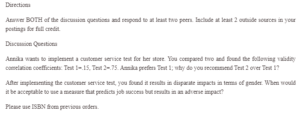Validity and Correlation Coefficients
Annika wants to implement a customer service test for her store. You compared two and found the following validity correlation coefficients: Test 1=.15, Test 2=.75. Annika prefers Test 1; why do you recommend Test 2 over Test 1?
The correlation coefficient ranges from -1 to 1, with -1 showing a perfect negative and perfect positive correlation (Glen, 2021). The two tests show different correlations. Both tests show that the correlation tends to be positive: 1. However, Test 2 shows a larger positive correlation value than Test 1. Statistically, the correlation tells the distances between the data points and how the data points could fit into an imaginary line plotted for the data. Since Annika wants to implement customer service to collect customer feedback, the second test would return feedback useful for the store. The test will return more accurate positive and negative answers relating to the store’s operation that can be useful for decision-making. The stronger positive correlation between the feedback and store operations, as shown by the correlation between the data points, can be used to determine what works and what does not work out.
After implementing the customer service test, you found it results in disparate impacts in terms of gender. When would it be acceptable to use a measure that predicts job success but results in an adverse impact?
The test showing disparate results on customer service based on gender indicates a need to investigate why there are differences based on gender. However, gender discrimination is unacceptable and unethical in a workplace environment. A measure that measures job success fairly for both genders would be acceptable to compare retainability due to job success between the two genders without any discrimination (Phillips & Gully, 2020). When assessing the job success of each employee, the correlation between the criterion used to measure the success and the test score can be used to determine the people who should be retained. However, gender should be a spurious variable. This indicates that the measure does not discriminate against employees and credit them based on gender, making it an acceptable measure of job success.
References
Glen, S. (2021). Correlation Coefficient: Simple Definition, Formula, Easy Steps. From StatisticsHowTo.com: Elementary Statistics for the rest of us! https://www.statisticshowto.com/probability-and-statistics/correlation-coefficient-formula/
Phillips, J. M., & Gully, S. M. (2020). Strategic Staffing (4th ed.). Chicago Business Press.
ORDER A PLAGIARISM-FREE PAPER HERE
We’ll write everything from scratch
Question 

Validity and Correlation Coefficients
Directions
Answer BOTH of the discussion questions and respond to at least two peers. Include at least two outside sources in your postings for full credit.
Discussion Questions
Annika wants to implement a customer service test for her store. You compared two and found the following validity correlation coefficients: Test 1=.15, Test 2=.75. Annika prefers Test 1; why do you recommend Test 2 over Test 1?
After implementing the customer service test, you found it results in disparate impacts in terms of gender. When would it be acceptable to use a measure that predicts job success but results in an adverse impact?
Please use ISBN from previous orders.